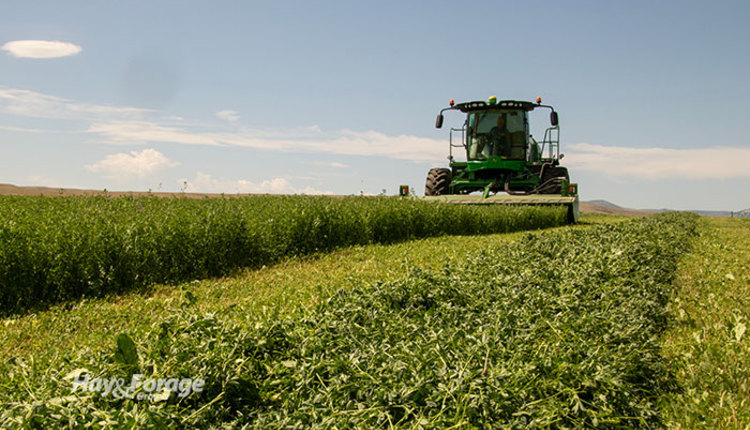
The critical fall period for alfalfa has been said to start about six weeks before the first killing frost, which is roughly around the first week of September for most of the Midwest. This hard stop in harvest schedules is supposed to ensure plants store enough energy in their roots to survive the winter, but with improved alfalfa varieties, variable stand conditions, and warmer weather patterns, how critical can this period really be?
Despite heat indices recently reaching the triple digits in some parts of the Central U.S., temperatures will likely calm down as we flip the calendar from August to September. The sun is also setting noticeably earlier each day, and the combination of milder temperatures and shorter day lengths sends a signal to alfalfa to prepare for fall dormancy.
Alfalfa will begin translocating energy produced during photosynthesis to its root system instead of using these carbohydrates to fuel vegetative growth and forage development. Plants perform this cycle after each cutting during the growing season, but they need to stock up on extra energy this time of year. Like a squirrel stores acorns in a hollowed-out tree for hibernation, alfalfa stores energy in its crown to survive the winter and kickstart growth again in the spring.
Better forage quality achieved by autumn weather may incentivize farmers to squeeze in one last cutting from their fields, but taking a hasty harvest of alfalfa when plants are in the process of moving photosynthates from shoots to roots can make them more vulnerable to winterkill and jeopardize future forage productivity. While the best solution is usually to skip this final cut, there are some situations where a fall harvest may be less risky, if not justified.
Plant genetics
Now that fall dormancy is no longer correlated with winter survival in improved varieities, there is some more wiggle room for harvesting alfalfa past the critical period. For example, forage with a fall dormancy rating of 4 or 5 will grow later into the season compared to forage with a fall dormancy rating of 2 or 3; however, the two varieties can be equally as winterhardy.
Alfalfa needs a high fall dormancy rating to warrant a late harvest. This allows forage to actively accumulate growing degree units after it is cut to facilitate the flow of carbohydrates to plant crowns. It generally takes about 500 growing degree units before a killing frost for root reserves to be adequately replenished, and alfalfa with a higher fall dormancy rating has a better chance of hitting this target.
Forage marked for a fall harvest must also have a high level of winter survival. The winter survival index is a scale from 1 to 6, which represent extremely winterhardy to not winterhardy.
Improved genetics are no match for Mother Nature, though, and an unexpected freeze can uproot the argument for another cutting. Growing an improved variety with too high of a fall dormancy rating for a particular region can also impair alfalfa’s ability to effectively go dormant before cold temperatures arrive.
Soil and stand conditions
In addition to forage genetics, stand condition and previous management can determine how well plants will respond to a late harvest. For instance, alfalfa that has been cut every 28 days or less during the summer might benefit from a bit of rest. Even though forage quality from a fall cutting could be significantly better than preceeding harvests, forage yield will probably be lower.
Soil fertility also factors into late cutting decisions, especially when it comes to potassium. This nutrient is crucial for the conversion of photosynthates to a storable form, as well as the translocation of nutrients to plant roots. Potassium is also imperative for overwintering and perennial forage persistence. If this nutrient is deficient in the soil, plants may have a hard time recovering from a fall cutting and living to see next spring.
These considerations support the notion of not cutting alfalfa stands with gas left in the tank, but what about forage that has already reached its peak performance? Research shows the second and third years after the seeding year are the most productive from a yield perspective, but then alfalfa stands start to decline.
Older stands are more susceptible to winterkill than younger ones, which should convince farmers to forget that last cut, but those with more risk tolerance might harvest hay if they are willing to terminate the aged alfalfa in the spring if forage doesn’t overwinter well.
With that said, alfalfa is easier to terminate in the fall. Rather than contemplate another cutting from an old stand, it may be more prudent to ponder applying herbicide now.
Weather impacts
Similar to the effects of a higher fall dormancy rating, delayed frost dates create wider windows of opportunity for fall harvests. Sources of greater authority than the Old Farmer’s Almanac report average killing frost dates are in fact occurring later year to year. But the keyword is average — there is always a possibility that an early killing freeze can ruin a producer’s plans.
Drought conditions earlier in the growing season likely lowered alfalfa yields in many regions. A fall harvest may be a last-ditch effort to make up for lost forage and stock up on bales before the winter begins. If this is the case, remember that cutting hay during the critical fall period usually reduces the first-cutting yields the subsequent spring.

